To the roof of Africa
In autumn 2010 I had a business meeting with Cecilie Skog and Bjørn Sekkesæter at the Åpent Bakeri café in Oslo. Cecilie is a Norwegian mountaineer and adventurer, and together we were looking into opportunities for a co-operation between her and NIVEA. We started the meeting by chitchatting a bit about my recent trip to Greenland and previous trips to Svalbard, and Cecilie’s and Bjørn’s previous expeditions and future plans. Cecilie is a very inspiring person, and by the end of the meeting she had convinced me that I was capable of things like crossing the Greenland inland ice, skiing to the South Pole, and climbing Mt. Kilimanjaro, the highest mountain in Africa at 5895 above sea level. Kilimanjaro is also one of the Seven Summits – the highest peaks of each continent.
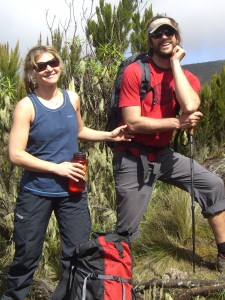
Our main guides Cecilie & Ryan
On this day the idea was born, and a bit more than a year later, I sent a mail to my boss practically begging to give me free despite our January sales meeting, so that I could join the trip to Tanzania. He approved my request, and on January 6th2012, I was standing outside my home in Pilestredet Park in Oslo at 3:30 AM waiting for Cecilie and Ryan to pick me up to the airport. Ryan Waters had crossed Antarctica together with Cecilie and had, just as Cecilie, climbed all Seven Summits and several 8000 meter tops in the Himalayas. On our way, we also picked up Bjørn as our third guide and his wife Marianne, and met the rest of our group at the airport: Inger, Stine, Gro, Trude, Trine, Marianne C., Sigriður, Ragna, Jørn, and Rolf, with whom I was going to share a tent. After a delayed flight from Amsterdam, we arrived at 11 PM at Kilimanjaro International Airport where our main local guide Faustin and his crew received us and drove us to our hotel for the first night.

Initial Seven Summits score at Machame Gate: Cecilie 7 - Stephan 0
Day 1: Machame Gate – Machame Hut
There are different routes up to Uhuru Peak, the top of Mt. Kilimanjaro. We were going to walk the Machame route, which is also known as the whisky route because it is long and tough, but you have a better chance to acclimatize to the high altitude on this route, which increases the chance to reach the summit.
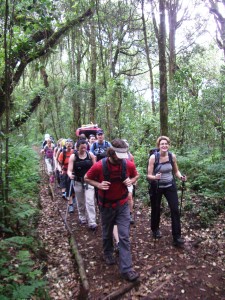
The first few kilometers go through the jungle
After breakfast we were driven to the park entrance Machame Gate at 1800 m, where we could meet our porters, cooks, and the rest of the team for the first time. In bright sunshine and 25 degrees we left for our first stage. The trail led us through the jungle the whole time with a very diversified vegetation – from dense and wild to rather airy. A small shower around noon could not rain on our parade. After a short lunch break at 1 o’clock we continued the ascent, and at 4.30 we reached our first camp close to Machame Hut at 3000 m. The first night in a tent is always wonderful, when you realize that you are so far away from civilization, and I enjoyed lying in my new sleeping bag, with rather pleasant temperatures outside.
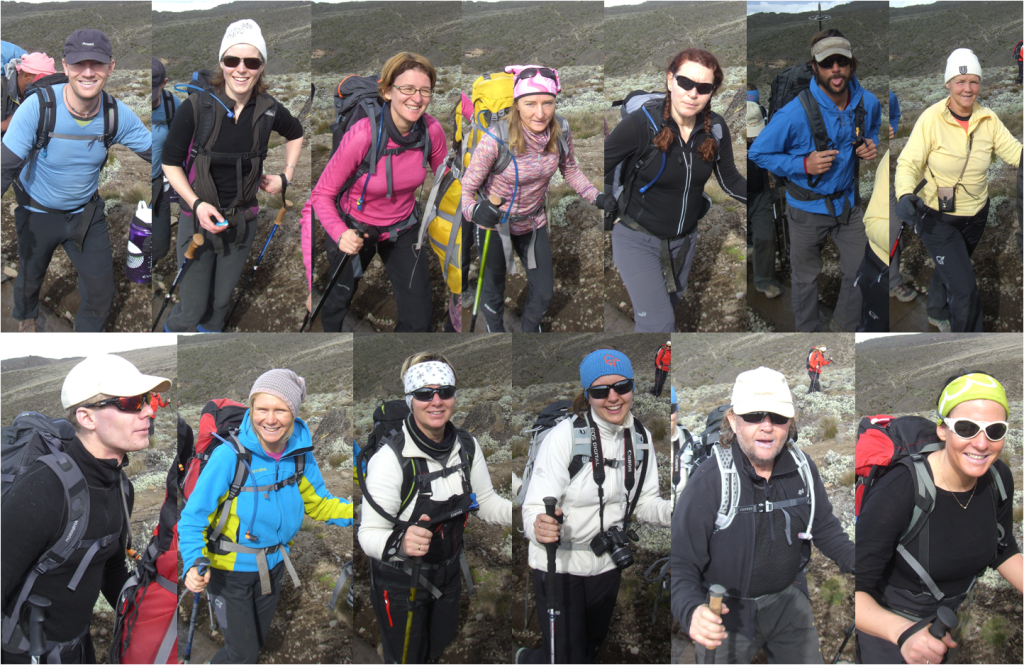
Our group: Bjørn, Marianne C., Ragna, Trine, Trude, Ryan, Inger, Rolf, Marianne S., Sigriður, Stine, Jørn, and Gro
Day 2: Machame Hut – Shira Hut
At 7 o’clock Leon, Faustin’s son and one of the other guides, woke us up with a cup of tea served in the tent. The breakfast consisted of porridge, egg, bacon and sausages, and we soon found out that the food during the whole trip should be excellent.
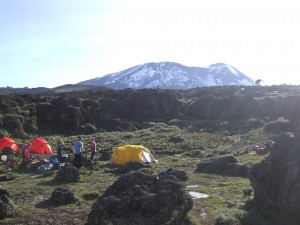
Morning idyll at Shira Camp
The sun was strong this morning, and on our way up from Machame Hut we quickly got our bodies on working temperature. Our guides asked us to walk “pole, pole” which means “slow, slow” in Swahili, so in a very slow tempo we ascended up to around 3600 m until we stopped for lunch. In the meantime the sky had become overclouded, so that we enjoyed lunch in a tent. After lunch we continued our ascent in a very interesting landscape: We had started the day under a clear blue sky and with a great view, now the fog together with the sparse trees created a somewhat spooky atmosphere. In between we heard some thunder, and a few raindrops fell, but we were lucky and did not get any heavy rain this day. When we arrived in Shira Camp at 3800 m, it was already quite chilly, and this should become the coldest night on our trip. I woke up during the night and had to put on an extra fleece because I froze.
Day 3: Lava Tower day
When we woke up there were ice crystals on the ground, but the sun quickly warmed up Shira Camp, and we could enjoy a great panorama towards Mt. Meru – the second biggest mountain in Tanzania.
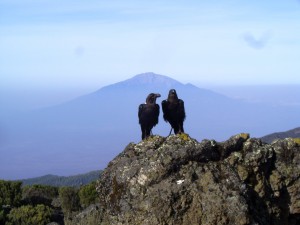
White necked ravens in front of Mt. Meru at Shira Camp
With T-shirts only, we left on our longest and toughest stage so far. Since we walked “pole, pole” and made a lot of breaks, we reached our lunch spot at 4500 m first around 2 o’clock. We had a little hail shower, so that we enjoyed lunch in the tent again. After lunch a part of our group continued to the highest point on this trip before the summit night: Lava Tower at 4630 m. From there we had a very nice descent through the Barranco Valley to our camp. We must have walked down a bit too fast, because at this point I was feeling nauseous for the first time. I still made myself eat some dinner to have enough energy for the notorious Barranco wall which we had to climb the next day right after breakfast.
Day 4: Barranco Wall
When we woke up this morning, the Barranco camp was lying in the sun, while the Barranco Wall was still in the shade at this time of day. Barranco Wall is also called Breakfast Wall – you climb it first thing in the morning, and rumours have it that a lot of hikers literally lose their breakfast during the ascent.
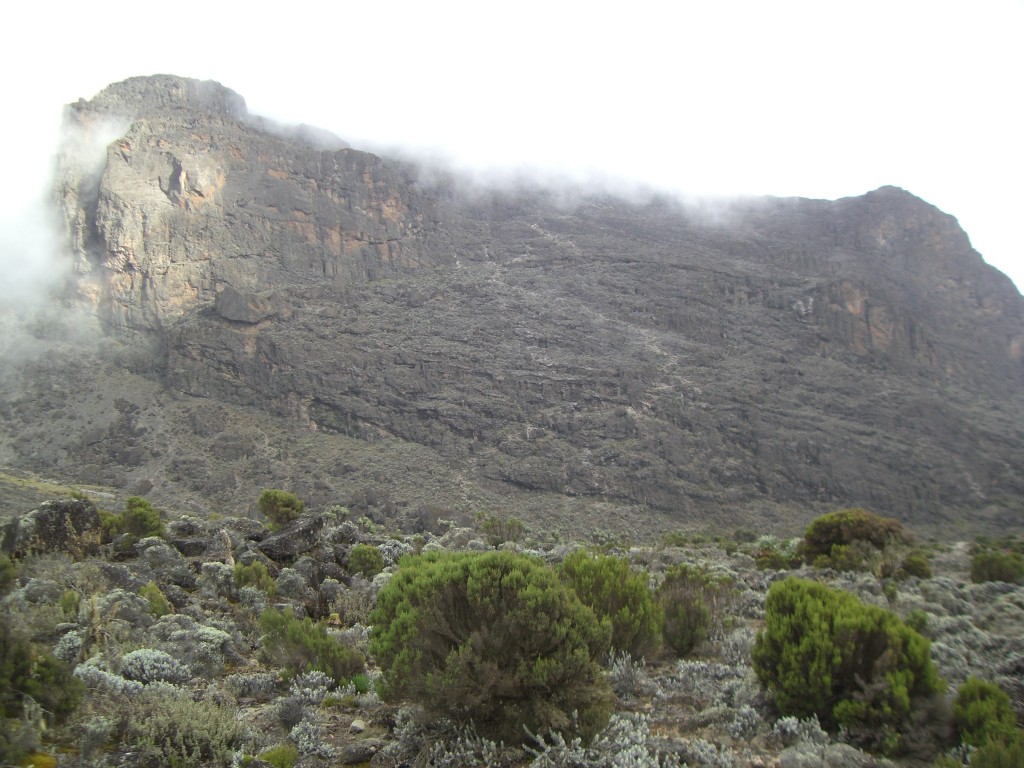
The notorious Barranco Wall
The wall was technically not difficult. We enjoyed to use our hands a bit and were impressed about the porters who balanced their heavy and often bulky load on their backs or on their heads. After a little less than two hours we reached a plateau and could enjoy a spectacular view over the plains around Kili and Mt. Meru. We reached our camp Karanga at 4050 m already at 1 o’clock so that we could enjoy half a rest day now.
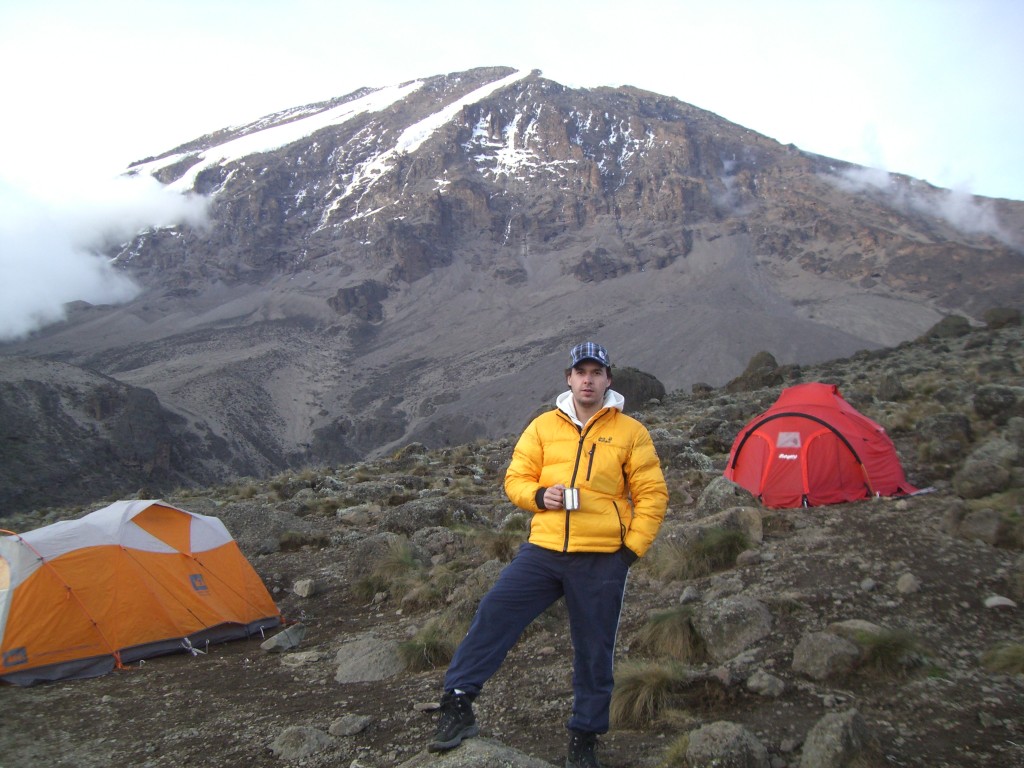
Half a day for relaxation at Karanga Camp
Day 5: Karanga Camp – Barafu High Camp
Another sunny day lay in front of us when we started to climb up to our last camp before the summit: the high camp Barafu at 4600 m.
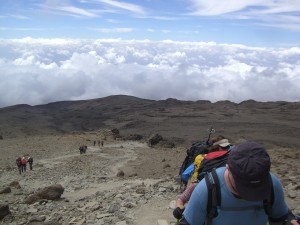
High above the clouds
Below us was a sea of clouds, and by now we had reached such a high altitude that I had expected this to become the coldest day so far. But it was so warm that we could actually lie in the sun with short sleeves during one of our breaks. Today we went purely through an inhospitable stone and lava desert, but thanks to the warm weather and the terrific view, it became a great day. The high camp was crowded and can be described as somewhere between Spartan and disgusting. There seems to be a negative correlation between the altitude above sea level and the size of the holes in the ground in the so called toilets. But anyway, we were supposed to stay here for half a day only, then go to bed early and try to sleep a few hours before the summit attempt.
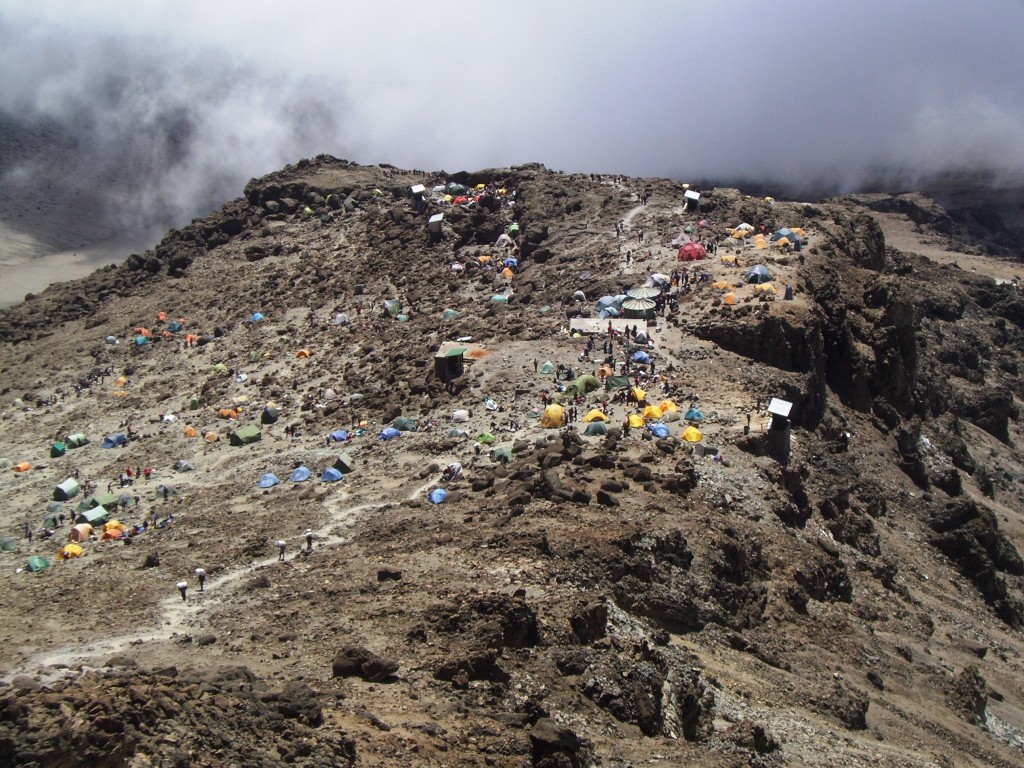
High camp Barafu at 4600 m
Day 6: Summit night
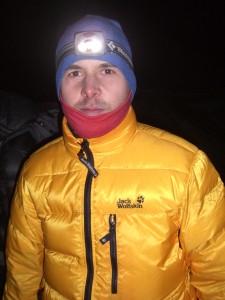
Ready for the summit
I could not sleep this night. When we were woken up at midnight to have a little snack and a cup of tea before we start our way to the summit, I had barely closed my eyes for half an hour. And while Cecilie previously had been surprised and content about everybody’s appetite (it is normal to lose your appetite in high altitude), I could not really eat anything this time. So we put on our down jackets and headlamps and left the camp at 1 AM. We could see that several groups had already left the camp before us as their headlamps were visible, slowly moving up the mountain in the distance. Although Cecilie and Ryan said that this night was much warmer than they were used to, it was much colder than I had expected. I was wearing wool underwear, two layers of fleece, a down jacket and a soft-shell, but I was still cold. I had a headache, my shoulders were hurting, and I was beginning to feel nauseous. During these hours before the sun came up, I frequently asked myself why the hell I was doing this and kept telling myself that I would certainly never climb any mountain again.
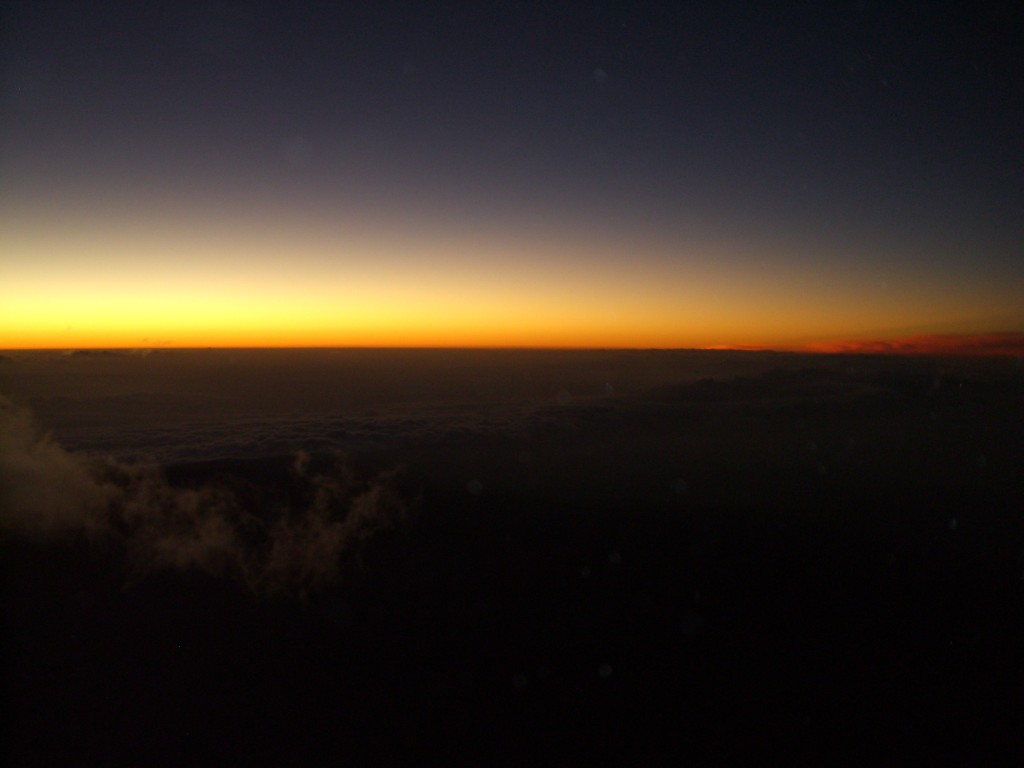
The last hour before sunrise was the hardest
We were taking breaks every hour, during which we were supposed to take off our backpacks and eat and drink a bit. I did not eat, but at least I tried to drink something. In the last break before sunrise I was so exhausted that I didn’t care to take off my backpack anymore.
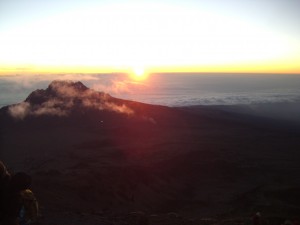
Finally the first sunbeams warm us up again
Dixon, one of our guides did a great thing then: He took off my backpack and started massaging my shoulders. That helped a lot. At 6 o’clock the sun rose above the horizon, which was the next psychological boost and helped us to get warmer again. At 7 o’clock we could see the crater rim, so we knew we had almost reached Stella Point at 5739 m. When you’ve reached Stella Point, our guides had told us, there’s no way that you will not make it to Uhuru Peak. The last fifteen minutes before Stella Point, I had a big lump in my throat and was almost moved to tears.
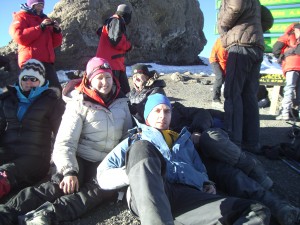
A very exhausted but happy gang at Stella Point
Reaching Stella point on the crater rim at 7.30 was an indescribable feeling. We stopped for almost half an hour – too exhausted to continue at once. We took some pictures. Then we left towards Uhuru Peak. This last section towards Uhuru Peak is a rather gentle slope which normally takes around 45 minutes. It is still tough because you are at an altitude of 5800 m, but it sure feels like a triumphal procession, too. Like a marathon runner on the home stretch – a very long home stretch. We reached Uhuru Peak at around 8.45 (not sure if I can trust my camera), and this was of course another very emotional experience. We didn’t arrive as one group. Small groups arrived one after the other – a hugging marathon after the hiking marathon.
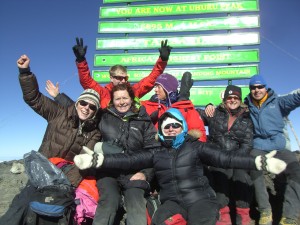
We've made it! On the top of Mt. Kilimanjaro at 5895 meters
We stayed quite a while (half an hour?) for taking pictures and to rest a bit before we started the descent. After 1300 m altitude difference up we also had to walk almost 2000 m altitude difference down again this day until we reached Millenium Camp at 3800 m and could treat ourselves with a cold Coke (and some of us with a cold beer). The next day we walked down another 2000 m through the jungle to Mweka Gate, a different gate than where we had entered the park. Here we experienced our first heavy tropical rain shower and actually got very wet during the last twenty minutes. But we were rewarded with cold champagne that was served for us at the gate. Now we could celebrate that we had actually made it and climbed one of the Seven Summits!
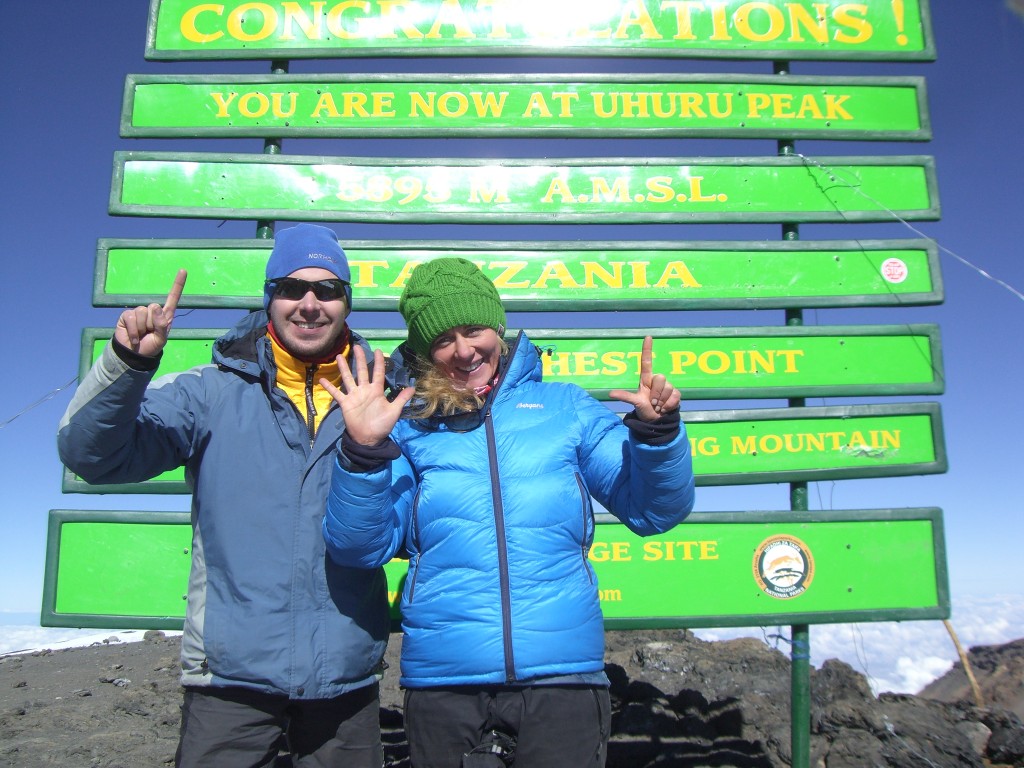
New Seven Summits score at Uhuru Peak: Cecilie 7 - Stephan 1!
From Mweka gate we went to Arusha, where we stayed at a hotel for two nights, before continuing to Ngorongora Crater and Serengeti for a two days’ safari. You can find impressions from this part of the trip in the photo gallery.

